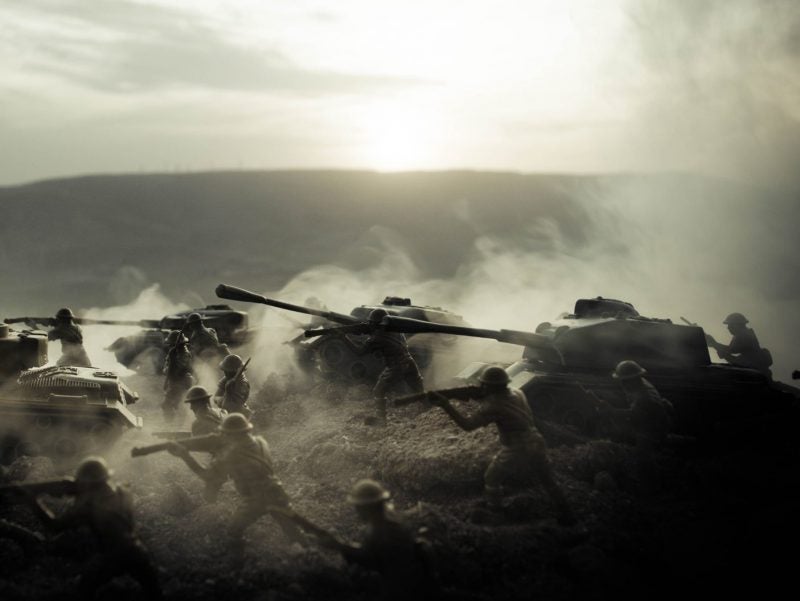
In December 2019, more than 40 Royal Air Force (RAF) officers took part in Eagle Warrior 19, a command and control wargaming exercise. Split into teams, they tried out a series of wargames – based on a combination of digital modelling, maps and manual table-top games – as a means of assessing their decision-making acumen.
In doing so, the RAF became the first customer to make use of the Defence Science and Technology Laboratory’s (Dstl) new Defence Wargaming Centre (DWC), which was officially launched the following month. Situated at Dstl’s Portsdown West campus, the facility is the UK’s first dedicated wargaming centre, set up to serve the RAF, the Royal Navy and the British Army.

Discover B2B Marketing That Performs
Combine business intelligence and editorial excellence to reach engaged professionals across 36 leading media platforms.
Reflecting on the inaugural Eagle Warrior 19 exercise, Group Captain Christopher Platt, Dstl’s senior air advisor, described it as “a genuinely ambitious experiment that challenged participants to think about command and control of the next generation Royal Air Force”.
“Staying one step ahead of an information savvy adversary is a constant challenge,” said Platt. “We will need to embrace a combination of information technologies such as cloud computing, edge processing, machine learning and automation, so this wargame was a good step towards understanding the pros and cons of different approaches.”
While no images have been released of the DWC, it reportedly covers roughly 600 square metres and features two large areas alongside a smaller open-plan area, which can be split into smaller cells if necessary. The facility can be configured to “deliver a wide variety of wargames of different types and sizes for a range of purposes,” said Dstl.
The evolution of Dstl’s wargaming tools
The advent of a new national wargaming centre doesn’t necessarily come as a surprise. Since being formed in 2001 – following the split of the now-defunct Defence Evaluation and Research Agency (DERA) from the UK Ministry of Defence – Dstl has constantly been tasked with delivering wargames on behalf of the MOD and other government departments.

US Tariffs are shifting - will you react or anticipate?
Don’t let policy changes catch you off guard. Stay proactive with real-time data and expert analysis.
By GlobalDataFor example, in 2011 Dstl’s Peace Support Operations Model (PSOM), a computer-based decision-making tool, was used by NATO’s International Security Assistance Force Joint Command (IJC) to support its peacekeeping operations in Afghanistan. In a report from the time, IJC credited the tool with potentially saving many lives.
While not pertaining specifically to Dstl, professional defence analysts also used wargames to look at available options at the start of the Ukraine crisis in 2014.
Dstl’s wargames have constituted a mix of manual simulation, such as board games, and computer-based modelling. The new wargaming centre is a direct response to the growing demand from the military for wargames as a means of supporting decision-making and national defence policy.
What is it that makes wargaming so appealing to branches of the military? In short, it allows participants to immerse themselves in the rigours and demands of developing strategies, but in a safe-to-fail environment where the risks and costs of live exercises and real operations are stripped away.
Inspired by commercial computer games
As commercial wargames have become increasingly popular with gamers, Dstl has been working more closely with video game developers to come up with novel approaches to military strategies. Last year, the agency awarded a two-year contract worth £1.5m to Slitherine, the publisher of the successful Command series of games who has supplied its professional edition military logistics simulator to a number of defence clients.
Dstl’s main rationale behind the decision was that commercial computer games are often more user-friendly and accessible than industrial simulation software.
Whether they are manual or computer-based, all wargames share the same ultimate goal. They serve to encourage participants to think innovatively and outside the box. They are there to help identify emerging issues, test hypotheses, assess alternate options and, ultimately, highlight the potential consequences of choices.
Dstl is reportedly already sizing up future upgrades to the physical space of the new wargaming centre. As part of a new recruitment drive, it is also looking to add to its wargaming teams. As the MOD’s only dedicated wargaming facility, it will be interesting to see which strategic capabilities the new Defence Wargaming Centre will have in store for the armed forces.





